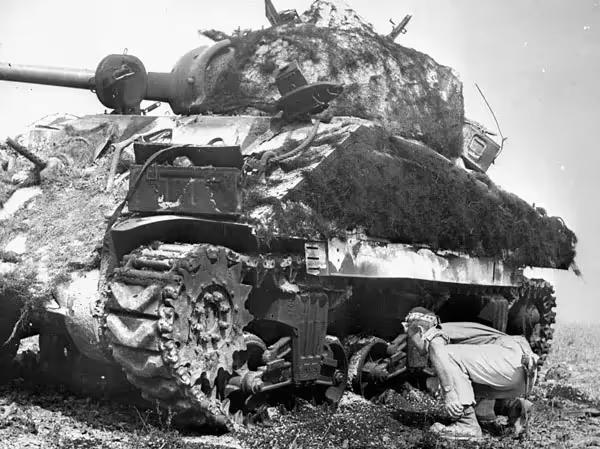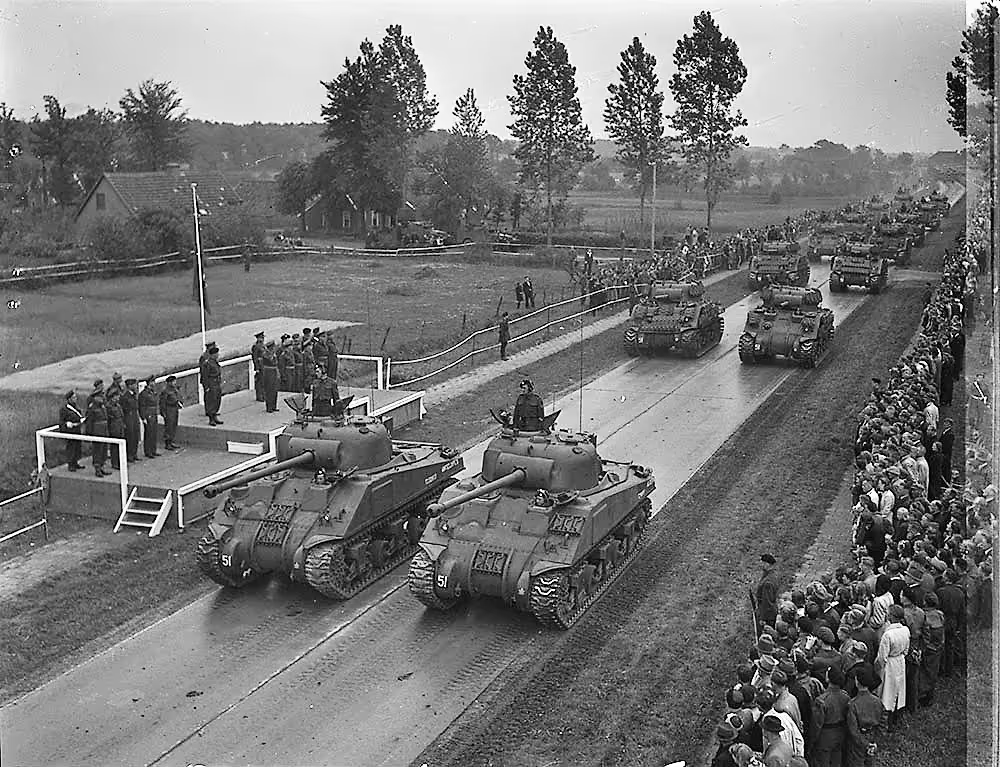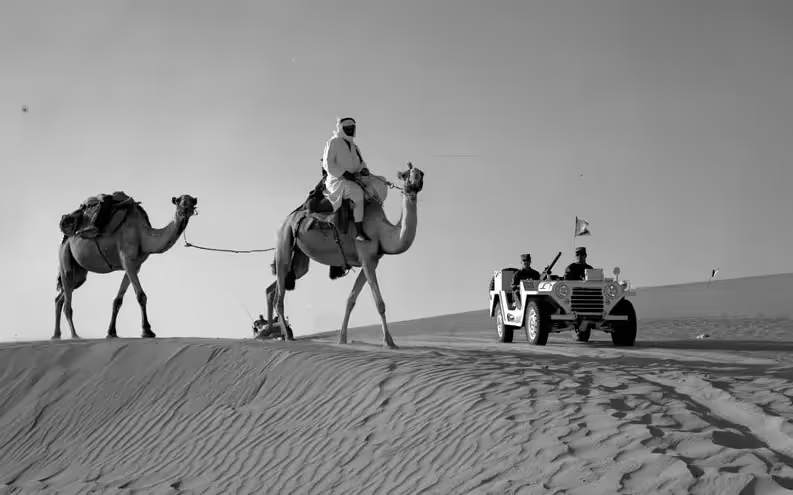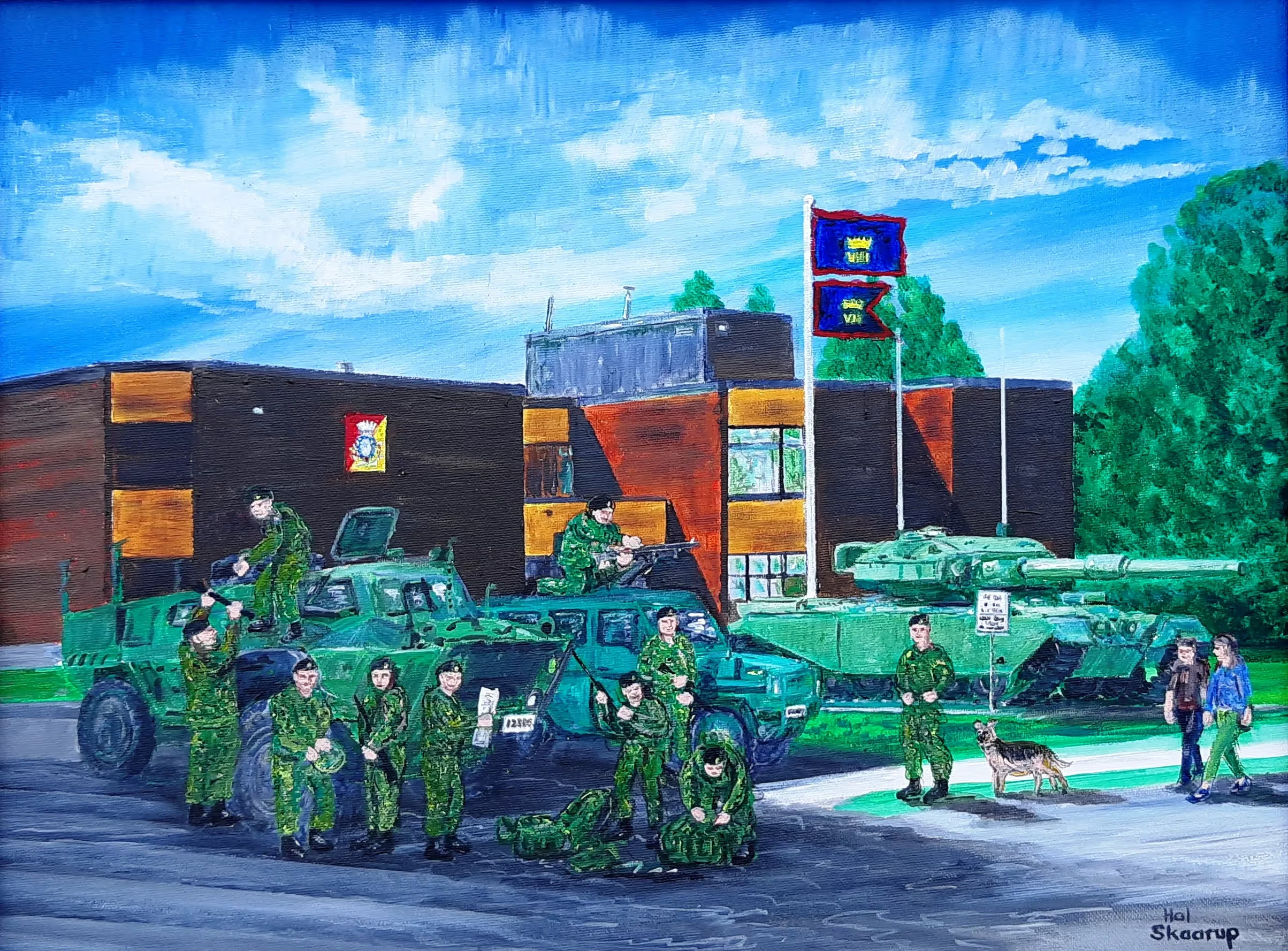8th Canadian Hussars (Princess Louise's), New Brunswick, a brief history, 1848 to the present day
The 8th Canadian Hussars (Princess Louise's)

The 8th Canadian Hussars (Princess Louise's) is one of the longest serving armoured regiments in the Canadian Army. A Squadron was a Regular Force element which served at CFB Gagetown (now 5 CDSB Gagetow), while B, C and HQ Squadrons were Reserve units which served in Sussex, Moncton and Sackville. In 1998 the Regular Force Squadron was disbanded and the regiment reverted to reserve status again.
The forerunner of the 8th Hussars was a cavalry unit known as Saunder's Horse, originally organized by descendants of a Loyalist named Colonel John Saunders who had migrated to New Brunswick in 1790. Colonel Saunders had formed Saunders Horse to fight the American colonists. When the war was over, thousands of Loyalists moved to New Brunswick and many settled in the Saint John and Kennebecasis Valleys. From these settlers seven troops of cavalry were drawn up. On the 4th of April 1848 these troops were incorporated to form a unit which was designated the New Brunswick Yeomanry cavalry. This date is known as the official birthday of the 8th Princess Louise’s New Brunswick Hussars.

(ebay Photo)
After Canada's Confederation the unit was known as the VIII Princess Louise's NB Regiment of Cavalry, and then later, the New Brunswick Regiment Yeomanry Cavalry on the 30th April 1869, based at Apohaqui, New Brunswick. The New Brunswick Regiment of Yeomanry Cavalry was composed from seven independent troops of cavalry authorized on the following dates: No. 1 Troop (Hampton Troop of Cavalry, 3 January 1866), No. 2 Troop (Assekeag Troop of Cavalry, 30 November 1864), No. 3 Troop (Apohaqui Troop of Cavalry, 3 January 1866), No. 4 Troop (Upham Troop of Cavalry, 3 January 1866), No. 5 Troop (Johnston Troop of Cavalry, 28 February 1866), No. 6 Troop (Shediac Troop of Cavalry, 13 June 1866), and No. 7 Troop (Springfield Troop of Cavalry, 21 June 1865). The units name again changed on the 31st of May 1872 when it was redesignated as the 8th Regiment of Cavalry.
In 1879, the Marquis of Lorne, the Governor General and his wife Her Royal Highness, the Princess Louise Caroline Alberta, the 31-year-old fourth daughter of Queen Victoria paid their first visit to New Brunswick. While in Saint John, a detachment of soldiers on horseback, from the 8th Cavalry provided their escort. It was out of this contact that the idea came to seek permission to have the 8th Cavalry designated as the Regiment of the Princess Louise.

(Library and Archives Canada Photos, MIKAN No. 3218462)
HRH Princess Louise, 1879.

(Library and Archives Canada Photos, MIKAN No. 3218465)
HRH Princess Louise, 1879.
When HRH Princess Louise gave permission for the use of her name in the Regimental title, the unit’s name was formally changed to the 8th Princess Louise's New Brunswick Regiment of Cavalry on the 18th of July 1884. The unit’s name was once again modified in August 1892 and officially redesignated on 1 January 1893 to the 8th Princess Louise's New Brunswick Hussars. The unit held this designation until it was disbanded and reorganized on the 1st of May 1920.
The regiment contributed volunteers for the Canadian Contingents that served in South Africa (11 October - 31 May 1902).

(ebay Photo)
During the Great War the regiment did not serve overseas as a separate unit. A Hussar Squadron reinforced the 6th Regiment, Canadian Mounted Rifles (CMR), Canadian Expeditionary Force (CEF), which embarked for England on 17 July 1915. It disembarked in France on 24 October 1915, where it continued to train until 2 January 1916 when its personnel were absorbed by the 4th and 5th Battalions of the CMR. Many individual members of the regiment joined other Canadian units overseas. The CMR was disbanded on 18 Feb 1918.
The 6th CMR earned the following battle honours:
Mount Sorrel, 2-3 June 1916; Somme 1916, 1 July - 18 November 1916; France; and Flanders 1915-16.



(Oromocto Legion Branch 93 Collection, Author Photo)
Second World War badge.
The Second World War provided the regiment’s first opportunity for active service as a formed unit. On the 24th of May 1940, elements of the Hussars were converted and redesignated into two units, 4th Canadian Motorcycle Regiment (8th Princess Louise's New Brunswick Hussars) CAAF; and the 5th (Reserve) Armoured Regiment (8th Princess Louise's New Brunswick Hussars) on the 1st of April 1941. The unit was mobilized in July 1940. They became the 5th Armoured Regiment (8th Princess Louise's New Brunswick Hussars) on the 11th of February 1941. This unit was the second senior armoured regiment in the 2nd Armoured Brigade, 5th Canadian Armoured Division, and embarked to sail to England on 9 October 1941.

(Library and Archives Canada Photo, MIKAN No. 3395994)
Personnel of the 8th Princess Louise's (New Brunswick) Hussars, Crookham, England, 16 April 1942.
The unit trained in England where it was renamed as the "5th Armoured Regiment (8th Princess Louise's (New Brunswick) Hussars, Canadian Armoured Corps (CAC), Canadian Army Special Force (CASF)", part of the 5th Canadian Armoured Division, on 15 October 1943. In 1943 it sailed for Italy, where it landed on 19 Dec 1943 at Naples and saw action soon and frequently thereafter. The regiment fought in the Liri Valley, the Melfa Crossing, Ceprano, The Gothic Line, Missano Ridge, Coriano, the Lamone River Crossing, and Coventello where it distinguished itself.

(Library and Archives Canada Photo, MIKAN No. 3599666)
A crew commander of the 8th Princess Louise's (New Brunswick) Hussars in the hatch of his Sherman tank giving firing orders to his gunner during a predicted mass tank firing exercise, Italy, 2 March 1944. The twin ring on the left are a sight added to the front "bladesight" which was used for firing indirect in a firebase position. The sight has crosshairs added front and back to aid int the direction of fire. Used in Tollo, Italy, 4 February 1944. There are 4 other photos from the same photographer from this shoot.

(Library and Archives Canada Photo, MIKAN No. 3599664)
Crew commander of the 8th Princess Louise's (New Brunswick) Hussars looking into his Sherman tank's access hatch during a predicted tank shoot, Italy, 2 March 1944.

(Library and Archives Canada Photo, MIKAN No. 3599666)
Crew commander of the 8th Princess Louise's (New Brunswick) Hussars in the hatch of his Sherman tank giving firing orders to his gunner during a predicted mass tank firing exercise, Italy, 2 March 1944.

(Bundesarchiv Bild 101I-478-2167-09)
And on the other side of the Gothic Line, a German Panzer V Panther tank crew commander was sizing up the Canadians, Italy, 1944.

(Bundesarchiv Bild 101I-478-2166-37)
And on the other side of the Gothic Line, a German Panzer V Panther tank crew commander was sizing up the Canadians, Italy, 1944.

(Bundesarchiv Bild 101I-478-2164-39)
The opposition: German Panzer V Panther tanks in Italy, 1944.

(Library and Archives Canada Photo, MIKAN No. 3512561)
Cape Breton Highlander examining the treads of a Sherman tank, possibly of "B" Squadron, 8th Princess Louise's (New Brunswick) Hussars, during the assault on the Gothic Line, Italy, ca. 31 August 1944.

A Squadron tank crew with their Sherman Mk. V medium tank in Italy, ca 1944. The early 30-ton Sherman had a five-man crew, a top speed of 29 mph and a cruising range of 150 miles. It mounted a 75-mm gun and carried two .30-calibre Browning machine-guns, and it was mechanically reliable.

LCpl Harold J. Skaarup (centre with pistol) and his A Squadron tank crew with their Sherman Mk. V medium tank in Italy, ca 1944.

(Library and Archives Canada Photo, MIKAN No. 3240626)
"Princess Louise", the mascot of the 8th Princess Louise's (New Brunswick) Hussars, who was found badly wounded after the battle of Coriano and nursed back to health by members of the regiment. Italy, 1944.

(DND Photo)
Operation Goldflake, 1st Canadian Corps with Sherman tanks of the 8th New Brunswick Hussars being loaded on Landing Ship Tank (LST) S263.
It moved to North-West Europe on 17 February 1945 as part of Operation Goldflake. The Hussars sailed from Italy to Southern France, and then moved by rail to Belgium in Northwest Europe. After refitting the tanks, the regiment went into action in the Netherlands, breaking through to Putten in mid-April. The regiment then moved north for the final actions of the war in the Delfzijl Pocket where 3,000 German soldiers surrendered to the regiment. It was renamed as the "5th Armoured Regiment (8th Princess Louise's (New Brunswick) Hussars, RCAC, CASF", on 2 August 1945.

(DND Photo)
Operation Goldflake, 1st Canadian Corps with 8th New Brunswick Hussars equipment loaded Landing Ship Tank (LST) 394 moving clear of harbour wrecks.

(Library and Archives Canada Photo, MIKAN No. 4166465)
LST 173 carrying a cargo of vehicles and supplies entering a harbour. Operation Goldflake was the administrative move of I Canadian Corps (in essence, all Canadian combatant units) and the British 5th Infantry Division from Italy to Northwestern Europe during the Second World War.

(Library and Archives Canada Photo, MIKAN No. 3396461)
Sherman M4A2 (75-mm) tank, 5th Canadian Armoured Division, 8th Princess Louise (New Brunswick) Hussars, en route to the Zuider Zee passing through Putten, Holland, 18 April 1945.

(Library and Archives Canada Photo, MIKAN No. 3396461b)
Sherman Firefly 1c with 17-pounder Gun, 5th Canadian Armoured Division, 8th Princess Louise (New Brunswick) Hussars, en route to the Zuider Zee passing through Putten, Holland, 18 April 1945.

(Library and Archives Canada Photo, MIKAN No. 3524765)
LCol Jack Eaton leading his regiment, the 8th New Brunswick Hussars, past the saluting base with General Crerar, GOC in C, 1st Canadian Corps, taking the salute at the review and marchpast. Eelde airport, Netherlands, 23 May 1945.

(Library and Archives Canada Photo, MIKAN No. 3524764)
LCol Jack Eaton leading his regiment, the 8th New Brunswick Hussars, past the saluting base in the review and marchpast of the 5 Canadian Armoured Division given by GOC in C of 1st Canadian Corps. General Crerar, Eelde airport, Netherlands, 23 May 1945.

(Library and Archives Canada Photo, MIKAN No. 3524758)
Troopers of the 8th Princess Louise's (New Brunswick) Hussars presenting arms upon the arrival of Lieutenant-General G.G. Simonds, Groningen, Netherlands, 12 November 1945.
On 26 January 1946, the regiment arrived in Halifax and the next day reached Sussex, New Brunswick where it was demobilized. The overseas regiment disbanded on 15 February 1946
The battle honours for the 5th Armoured Regiment (8th Princess Louise’s New Brunswick Hussars) from the Second World War include:
LIRI VALLEY, 18-30 May 1944; Melfa Crossing, 24-25 May 1944; Ceprano, 26-27 May 1944; GOTHIC LINE, 25-August - 22 September 1944; Montecchio, 30-31 August 1944; Tomba di Pesaro, 1-2 September 1944; LAMONE CROSSING, 2-13 September 1944; Coriano, 3-15 September 1944; Missano Ridge, Conventello-Comacchio, 2-6 January 1945; ITALY, 1944-1945, Ijsselmeer, 15-18 April 1945; Delfzijl Pocket, 23 April-2 May 1945; NORTH-WEST EUROPE, 1945.
Following the end of the war, the Hussars went back to being a reserve unit. They were again reorganized as the 5th Armoured Regiment (8th Princess Louise's (NB) Hussars in May 1946. This changed again to the 8th Princess Louise's (New Brunswick) Hussars (5th Armoured Regiment) on the 4th of February 1949.
In 1950, the regiment was again called on to provide soldiers to the Special Force which Canada dispatched to Korea, and in 1951 “Y” troop was organized for service in Canada’s NATO Brigade in Germany. (Lord Strathcona's Horse (Royal Canadians), A, B and C Squadrons fought independently in Korea from 19 April 1951 to 27 July 1953 as part of the 25th Canadian Infantry Brigade Group, 1st Commonwealth Division. The Squadrons were equipped with M4A3E8 Sherman tanks).

(DND Photo)
Canadian Sherman M4A2 (76) W HVSS, Korea, ca 1953.

(DND Photo)
Canadian Sherman M4A2 (76) W HVSS, "CHEETAH", Korea, ca 1953.

(Library and Archives Canada Photo, MIKAN No. 4234039)
M4A2 (76) W HVSS Sherman, Camp Petawawa, Ontario, ca. 1963.

(DND Photo)
M4A2 (76) W HVSS Sherman, Camp Gagetown, New Brunswick, ca 1960s.

(York Sunbury Historical Society, Fredericton Region Museum Collection, Author Photo)
Accession No. 1997.28.484.
On the 29th of January 1957 the unit was reorganized into the 8th Canadian Hussars (Princess Louise's) 1st and 2nd Regiments. In February 1958, the Regiment’s Reconnaissance Squadron left Canada to serve with the UN Expeditionary Force in the Suez Canal area, where it remained for a year. It would later return for an additional tour in 1964.

(Library and Archives Canada Photo, MIKAN No. 4235424)
Centurion tank on exercise in the Camp Gagetown training area, ca 1958.

(Library and Archives Canada Photo, MIKAN No. 4235808)
Centurion tank on exercise in the Camp Gagetown training area, ca 1958.
Effective the 1st of January 1960, the unit’s designation became the 8th Canadian Hussars (Princess Louise's) and the 8th Canadian Hussars (Princess Louise's) (Militia).

(Library and Archives Canada Photo, MIKAN No. 4301771)
HRH Princess Margaret visiting the 8th Canadian Hussars at Camp Gagetown, New Brunswick, Aug 1958. Trooper Ernie Budd is the mascot handler, Colonel S.V. Radley-Waters is behind her, the Centurion crew commander is Sergeant Ross Stoddart, and the British Officer is HRH Aide-de-Camp.
In December 1958 the Regiment was informed it would join 4 Canadian Infantry Brigade Group in Germany the following year. An advance party under Major Brennan left for Germany in late September 1959, while Lieutenant-Colonel Radley-Walters and the main force departed from Quebec City several weeks later. By mid-November, the Hussars were stationed at Fort Beausejour, just west of Iserlohn in West-Central Germany.
The Regiment returned to Canada in 1962, but three years later, 'C' Squadron would return to Germany to provide reconnaissance for 4 Canadian Infantry Brigade Group until 1970.

(8th CH Association Photo)
8th Canadian Hussars, Centurions on parade at Fort Beausejour, just west of Iserlohn in West-Central Germany, ca 1959-1962.

(DND Photo)
Hiller CH-112 Nomad helicopters in service with 8th Canadian Hussars Ferret Scout cars, Germany, ca 1959-1962.
The Nomad helicopter served with the Canadian Army in the utility and aerial observation role, starting in 1961. Twenty-four were assigned to the units within the Canadian Army, including Europe. The Nomad was used by the 8th Canadian Hussars - Helicopter Reconnaissance Troop, Command and Liaison Flight of 4 CMBG HQ and Signals Squadron and the Aircraft Repair Platoon. All amalgamated to become 444 Squadron on 1 Oct 1972 and were re-equipped with the Bell CH-136 Kiowa helicopter.

(Library and Archives Canada Photo, MIKAN No. 4234835)
8th Canadian Hussars Ferret Scout Car on patrol during an exercise in Northern Germany, ca 1961.

(Library and Archives Canada Photo, MIKAN No. 4234827)
8th Canadian Hussars Ferret Scout Car on patrol during an exercise in Northern Germany, ca 1961.

(Library and Archives Canada Photo, MIKAN No. 4234829)
8th Canadian Hussars Ferret Scout Car on patrol during an exercise in Northern Germany, ca 1959-1962.

(Library and Archives Canada Photo, MIKAN No. 4235688)
Centurion tanks, 8th Canadian Hussars (Princess Louise’s), on exercise in Germany, ca 1959-1962.

(Library and Archives Canada Photo, MIKAN No. 4235689)
Centurion tanks, 8th Canadian Hussars (Princess Louise’s), on exercise in Germany, ca 1959-1962.

(Library and Archives Canada Photo, MIKAN No. 4235690)
Centurion tanks, 8th Canadian Hussars (Princess Louise’s), on exercise in Germany, ca 1959-1962.

(Library and Archives Canada Photo, MIKAN No. 4235750)
Centurion tanks, 8th Canadian Hussars (Princess Louise’s), on exercise in Germany, ca 1959-1962.

(Library and Archives Canada Photo, MIKAN No. 4235434)
MGen (DSO, MBE), with Army Aviation wings and LCol Quinn, 8CH, Camp Gagetown, New Brunswick, summer concentration, 1963.

(Library and Archives Canada Photo, MIKAN No. 4234489)
8th Hussars mascot (a deer), Camp Gagetown, ca 1965.
During its service the Regular Regiment has served at Camp Gagetown, New Brunswick, Camp Petawawa, Ontario, the Sinai, Cyprus, Iserlohn (Fort Beausejour), Soest and Lahr, West Germany.

(Library and Archives Canada Photo, MIKAN No. 4117928)
MUTT M-151 Truck, Utility, 1.25-ton, 4 X 4 Jeep (G838), with camels during 8th Canadian Hussars Reconaissance Patrols of the Sinai desert, 11 Aug 1964.
In 1964, the 8th Canadian Hussars were tasked with manning a sector of the armistice line on the Gaza Strip. The Hussars deployed ‘D’ and ‘A’ Squadrons for 12-month rotations in the country. Cpl. Paul R. Wallace and Tpr. Adrian A. Bons died while deployed to the Sinai as part of the United Nations Emergency Force on 27 Nov 1964.

(8th CH Association Photo)
8th Canadian Hussars Observataion Post, Sinai desert, ca 1964.
In February of 1964, D Squadron was based at Camp Rafah, Egypt, in the Gaza Strip. The Canadians were to serve as a shield between the Israel Defense Force and the Egyptian military. The Hussars took over the duties of Lord Strathcona’s Horse, who were repatriated to Canada. The Regiment’s main operational centre within Camp Rafah was Fort Worthington. When not in the Camp, D Squadron maintained two permanent outposts along their assigned section of the ‘International Frontier.’ The northernmost position was Fort Robinson; from there, the line was held by the Brazilians. The Southernmost position was called Fort Saunders; further south, the line was held by the Yugoslavs. Between these two posts, the Squadron was responsible for patrolling over 30 miles of border.
In terms of logistics, the Squadron was divided into troops. This ensured that they had sufficient manpower to maintain a continual presence along their defensive line. Moreover, it allowed for the rotation of soldiers into, and out of, the demarcation zone. Finally, this arrangement allowed the frontline soldiers to be taken from the line for rest and relaxation. The Hussars were equipped with American Jeeps, Browning 9-mm pistols, and several Browning machine guns for good measure. There were considerable challenges that fell on the border area under the operational control of the United Nations. First, the Hussars had to be vigilant of the operations being conducted by the Israelis and Arabs on both sides of the border. However, a more pertinent issue was the constant violations of the border by the Bedouins, nomads, and Palestinians. This could often raise the ire of Israeli soldiers resulting in skirmishing. The most pressing danger experienced by the Hussars, however was contending with the thousands of mines which remained buried following the disengagement of the Israelis and Egyptians.
While making their rounds, two Hussars picked up a Bedouin infiltrator. On their return journey to Camp Rafah, the set off an anti-tank mine which killed all three and destroyed their Jeep. Corporal Paul Wallace and Trooper Adrian Bons were buried with full military honours at the Gaza War Cemetery. (As a memorial to Tpr Bons and Cpl Wallace, their vehicle pennant, recovered from the site, is on permanent display at the 8th Hussars Museum in Sussex, NB).
D Squadron finished their peacekeeping tour without further incident. A Squadron relieved D Squadron in Feb 1965, and was the last of the Hussars to participate in Peacekeeping with the UNEFI in Gaza. In Feb 1966, they were rotated out and their positions werre taken up by the Brazilians in the North and the Yugoslavs in the South. (Hayden Johnson)
In the summer of 1965, the regiment was deployed from their base at Camp Petawawa, Ontario on a peacekeeping mission for the United Nations to the island nation of Cyprus. Tpr. Lennard W. Nass died on 27 Sep 1966 while deployed to Cyprus as part of the United Nations Force in Cyprus.
The Regular Regiment was stationed at Camp Petawawa (later renamed CFB Petawawa and currently 4 CDSB Petawawa) from 1962 until July 1987, when it moved to CFB Lahr where it became part of 4 Canadian Mechanized Brigade Group.
The 8th Canadian Hussars relieved the Royal Canadian Dragoons at CFB Lahr. The Regiment took part in the annual Reforger exercises, which simulated rapid deployment of military forces to Germany in event of a major conflict with the Soviet Union and/or its allies.
When the Berlin Wall came down in 1989, the Regiment was equipped with 77 Leopard C1 tanks, 20 Lynx armoured reconnaissance vehicles, 36 M113 armoured personnel carriers, 2 M577 command vehicles, and 6 Bergepanzer armoured recovery vehicles.
With repatriation during the summer of 1993 due to the closure of CFB Lahr, the Regiment became Canada's first Total Force Armour Regiment by amalgamating the Regular and Reserve Regiments. CFB Lahr was formally closed in 1994.
On the 15th of April 1993 the 8th Canadian Hussars (Princess Louise's) (Militia) and the 8th Canadian Hussars (Princess Louise's) were amalgamated and redesignated as the 8th Canadian Hussars (Princess Louise's). Regimental Headquarters and Headquarters Squadron are located in Moncton, “A” Squadron at CFB Gagetown, “B” Squadron in Sussex and “C” Squadron in Sackville.

(Author Photo)
Ferret Scout Car, Sackville Memorial Park, New Brunswick.

(Author Photo)
M4A2 (76) W HVSS Sherman, Coriano, Moncton, New Brunswick.

(Author Photo)
Centurion tank, previously located in front of the Moncton Armoury, now in front of the Armoury in Sussex.

(Author Photo)
Centurion tank, Riverview City Hall, Memorial Park, New Brunswick.

(Author Photo)
Leopard tank, "Hussar", Moncton Sports Centre, New Brunswick.

(Author Photo)
M4A2 (76) W HVSS Sherman, previously outside the Main Gate, now on the memorial lane past the front gate on the south side, 5 Canadian Division Support Base, Gagetown, New Brunswick.

(Author Photo)
M4A2 (76) W HVSS Sherman, "Addy", Armour School, 5 Canadian Division Support Base, Gagetown, New Brunswick.

(Author Photo)
Centurion tank, "Worthy", Armour School, 5 Canadian Division Support Base, Gagetown, New Brunswick.

(Author Photo)
Leopard tank, "Nixon", Armour School, 5 Canadian Division Support Base, Gagetown, New Brunswick.

(Author Photo)
Centurion Tank, New Brunswick Military History Museum AFV Park, 5 CDSB Gagetown.

(Author Photo)
Centurion Tank, Tilley Avenue, 5 CDSB Gagetown, New Brunswick.

(Author Photo)
Centurion Tank, "Ironsides", Oromocto, New Brunswick.

(Author Photo)
M4A2 (76) W HVSS Sherman, Sussex, New Brunswick.

(Author Photo)
AVGP Cougar, Sussex, New Brunswick.
The regiment has participated in several "aid to the civil authority" missions in recent history. In the summer of 1990 the regiment sent a troop sized force to the province of Quebec in Cougars to assist in Canadian Forces Operations in the Oka Crisis. In the 1998 Ice Storm, the regiment provided a platoon-sized force to assist in the maintenance of infrastructure in the community of St. George, New Brunswick. In the fall of 1998, the regiment provided soldiers to the recovery effort for Swiss Air Flight 111.

(DND Photo)
Mercedes-Benz G-Wagons, Kabul, 2004.
In 2004, the 8CH became an armoured reconnaissance unit, in place of its previous designation as simply an armoured unit. Along with this trade change the unit was given the new Mercedes-Benz G-Wagon, a Jeep-like vehicle more suited to their new role as reconnaissance. The unit is stationed at the Moncton and Sussex detachments of 5 Canadian Division Support Base Gagetown, New Brunswick.
The regiment contributed an aggregate of more than 20% of its authorized strength to the various Task Forces which served in Afghanistan between 2002 and 2014.
.avif)
(Author Photo)
M113 C & R Lynx, Sussex, New Brunswick, 21 Oct 2017.
.avif)
Author with HCol Lockyer and Tom MacLaughlin, 8th Hussars on parade, Sussex, 21 Oct 2017.

(Library and Archives Canada Photo, MIKAN No. 4443960)
The 8 CH Colonel-in-Chief is HRH The Princess Royal.


(Avery MacRae/CTV Atlantic)
Princess Anne inspects her troops as colonel-in-chief of the 8th Canadian Hussars on 21 May 2023.
Guidon

Guidon of the 8th Canadian Hussars (Princess Louise's).

8th Hussars preparing to go on exercise. Author's artwork, commission for LCol Tom Peppard.
.

(York Sunbury Historical Society, Fredericton Region Museum Collection, Author Photo)
Accession No. 1997.28.28.

